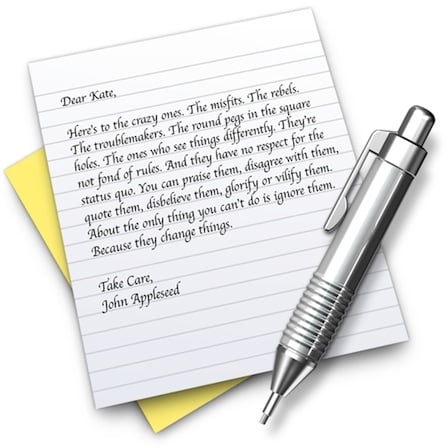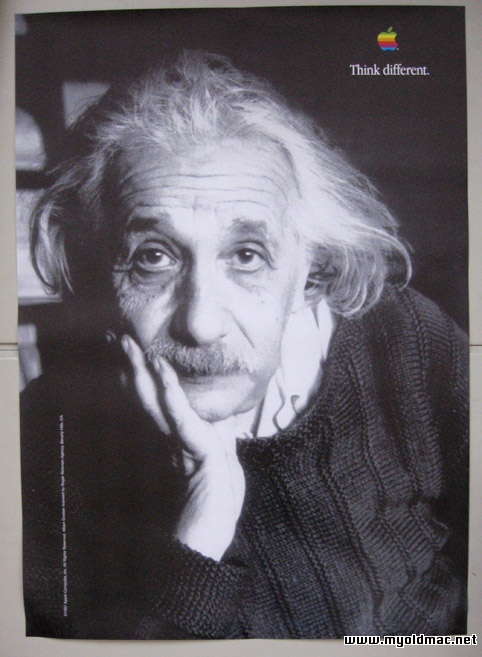The “think different” ad campaign was one of Apple’s most influential advertisements ever. It was created in 1997 (my birthday!) and restored Apple to its once famous image. The ad came in many formats: a famous television commercial (which I will show you later), several print advertisements and a number of TV promos for Apple products.
 Apple was loosing a good reputation as a company before the ad launched due to Steve Jobs, The founder of Apple Computer.inc, being fired from his own company! The company went readily downhill. A lot of the Apple supporters left to competitors for better equipment and processors (Apple was using PowerPC, whereas Intel was the up and coming standard). Even worse, the million-dollar project, The Apple Newton, a PDA type device, was largely unsuccessful, loosing Apple Millions. The advertisement, in many ways, marked a significant turning point in Apple’s history, as the re-emergence as one of the major tech giants. Along with the ad, the return of Steve Jobs and a whole bunch of new revolutionary products (including the iMac, Mac OS X and the PowerBooks), really pushed Apple back into the competitive game of tech.
Apple was loosing a good reputation as a company before the ad launched due to Steve Jobs, The founder of Apple Computer.inc, being fired from his own company! The company went readily downhill. A lot of the Apple supporters left to competitors for better equipment and processors (Apple was using PowerPC, whereas Intel was the up and coming standard). Even worse, the million-dollar project, The Apple Newton, a PDA type device, was largely unsuccessful, loosing Apple Millions. The advertisement, in many ways, marked a significant turning point in Apple’s history, as the re-emergence as one of the major tech giants. Along with the ad, the return of Steve Jobs and a whole bunch of new revolutionary products (including the iMac, Mac OS X and the PowerBooks), really pushed Apple back into the competitive game of tech.
So, lets start at the beginning. When Steve introduced the ad campaign in 1997, he talks about core values of a company and how each company needs investment of interest to remain relevant. He continues by saying Apple has lost this and the way to bring it back is “not to talk about why we are better than windows,” so, basically, not to talk about the product. He then goes onto mention the “Got milk?” and the Nike adverts and how they never once mentioned the product on offer. Then, we come to the main point, core values of a company. Apple’s core values are interesting, so I am not going to ruin the surprise for you now, you will have to watch the video. The campaign is all about Apple honoring the people who “think different and move this world forward”.
So Apple is completely cutting out the product from the equation and just expressing what the company believes in. In my opinion, Apple still retains this core value to this day. They have changed the market with the iPad, been majorly involved with the adoption of USB, invented firewire, created the first wireless internet devices and now introducing a new technology which will be 20 times faster than USB and firewire, Thunderbolt.
Now, let me show you the original Think different advertisement.
Transcript: “Here’s to the crazy ones. The misfits. The rebels. The troublemakers. The round pegs in the square holes. The ones who see things differently. They’re not fond of rules. And they have no respect for the status quo. You can quote them, disagree with them, glorify or vilify them. About the only thing you can’t do is ignore them. Because they change things. They push the human race forward. And while some may see them as the crazy ones, we see genius. Because the people who are crazy enough to think they can change the world, are the ones who do.”
As you may have noticed, there are a lot of famous people who have changed the world portrayed in the ad. In order of appearance they were: Albert Einstein, Bob Dylan, Martin Luther King, Jr., Richard Branson, John Lennon, Buckminster Fuller, Thomas Edison, Muhammad Ali, Ted Turner, Maria Callas, Mahatma Gandhi, Amelia Earhart, Alfred Hitchcock, Martha Graham, Jim Henson with Kermit the Frog, Frank Lloyd Wright, Pablo Picasso and Shaan Sahota, who is opening her eyes as though to see the possibilities that await her.
The advertisement portrays these people because each and every one has changed the world in some way. They Thought outside the box, pushed boundaries and were in the end, considered crazy. Look at A. Einstein; he changed and revolutionized the world with his theories, but he was definitely crazy! Instead of doing the normal thing: get a paying job and just get on with it, he dared to think differently. The same will apply to all the people shown in the ad, except for the fact that Einstein died poor.
For me, this advertisement was very inspiring. It is a unique and iconic advert, which really lifts ones spirit up when it has been watched. It takes the old lesson of “don’t be afraid to be different” and applies it to the people who many look up to, saying they took the chance and did not respect the status quo. If those people did not “think different”, then the human race would not be where it is today.
The advert, upon release, was a huge success. Critically acclaimed, it won the 1998 Emmy Award for Best Commercial and the 2000 Grand Effie Award for most effective ad campaign in America.
This advertising approach has been adopted by many brands recently. One example is YeoValley with their rap song:
In many cases, one could claim this advert does not follow the same principles as the “Think Different” ad, and, like all good analysis’s, I see how. This ad does include the product, however, it did not play a big role. In my opinion, the advert is promoting country life and “ living in harmony” more than it did the milk and yoghurt. How often (if you live in the UK) have you heard this song, immediately recognised it and then sang along to it? If you have done it even once, then the ad was a success. I will remember YeoValley for this song and not the milk they sell, just like I will remember Apple for its innovations and not the products.
On a more trivial side, the Think Different ad campaign has received criticism over the grammar of the ad. "Think" is a verb and should take an adverb (like "differently") and not an adjective (like "different"). On the other hand, in certain expressions such as "think big", this rule can be changed to achieve impact. Furthermore, “Different” as a noun can be used in the quote “Think Different” to express what to think instead of how to think.
A quote from Wikipedia: “In addition, the difference in the usage of the word "Different" from normal usage in the slogan serves as an example of its own meaning. It certainly wasn't created by people who think differently - it was created by people who think different.”
Continuing on the trivial side, this ad has undoubtedly been susceptible to a parody or two:
Hunter Cressall made a parody of Apple's commercials, showing problems he has had with Macs. After the ad, the slogan "Crash Different" is shown.
ICAT Bangalore issues its students a pamphlet, which has the tag-line "think different" with the second 'e' flipped.
The episode "Mypods and Boomsticks" of “The Simpsons” makes fun of the slogan, writing it "Think Differently", because the slogan is not grammatically correct. There is also the possibility that the creators did not want to be sued by Apple for using their trademark without permission!
Returning to a serious topic, the ad left a long lasting legacy (notice alliteration), supported by many product packages, the current Apple operating system and even the Apple.com site over the years.
Since late 2009, the packaging specification sheet for the iMac have included the footnote:
Macintosh Think different.
When Mac OS X was launched, Apple used part of the text used in the ad in its high resolution TextEdit logo (equivalent to notepad for all those using a slow, buggy PC).
On at least five separate occasions, the Apple homepage featured images of notable figures not originally part of the advert alongside the "Think Different" slogan:
▪ In 2001, when George Harrison died
▪ In 2002, when Jimmy Carter won the Nobel Peace Prize
▪ In 2003, when Gregory Hines died
▪ In 2005, when Rosa Parks died
▪ In 2007, when Al Gore received the Nobel Peace Prize
Apple still quite often quotes the slogan on stage during product announcements.
There have been many manifestations of this ad. There are several shorter television commercials with a shortened version of the text and many different posters, as shown. There are many more of these posters but there are too many to show here.
So, overall, the apple “Think Different” advertising campaign was extremely effective in promoting Apple as a company, resulting in more sales and restoring Apple to its once influential self.
Please note: Most the information in this post is from personal knowledge, however, there are a few bits of information taken and cross-referenced from wikepidia.org. It is impossible for me to know that when George Harrison died when I was 3, the picture on the Apple home page, for example! I would also like to mention my good friend Jack. U (www.jackusher.co.uk), who showed me this ad for the first time. I look forward to him showing me more interesting things in the near future.






